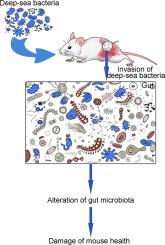Journal of Advanced Research ( IF 10.7 ) Pub Date : 2022-06-09 , DOI: 10.1016/j.jare.2022.05.011 Mengqi Chu 1 , Xiaobo Zhang 1

|
Introduction
Deep sea has numerous bacteria which dominate in the biomass of deep-sea sediments. Some deep-sea bacteria may possess the capacity to destroy mammal health by the alteration of gut microbiota, acting as potential pathogens.
Objectives
Pathogenic bacteria are great threats to human health. However, the ultimate origin of pathogenic bacteria has not been intensively explored. In this study, therefore, the influence of deep-sea bacteria on the gut microbiota was evaluated on a global scale.
Methods
The bacteria isolated from each of 106 deep-sea sediment samples were transplanted into mice in our study to assess the infectiousness of deep-sea bacteria.
Results
The results showed that some bacteria from deep sea, an area that has existed since the earth was formed, could proliferate in mouse gut. Based on the infectious evaluation of the bacteria from each of 106 deep-sea sediments, the bacteria isolated from 13 sediments invaded the gut bacterial communities of mice, leading to the significant alteration of mouse gut microbiota. Among the 13 deep-sea sediments, the bacteria isolated from 9 sediments could destroy mouse health by inducing glucose metabolism deterioration, liver damage and inflammatory symptom. As an example, a bacterium was isolated from deep-sea sediment DP040, which was identified to be Bacillus cereus (termed as Bacillus cereus DP040). Bacillus cereus DP040 could invade the gut microbiota of mice to change the gut microbial structure, leading to inflammatory symptom of mice. The deep-sea sediments containing the bacteria destroying the health of mice were distributed in hydrothermal vent, mid-ocean ridge and hadal trench of the Indian Ocean, the Atlantic Ocean and the Pacific Ocean.
Conclusion
Our findings demonstrate that deep sea is an important origin of potential pathogenic bacteria and provide the first biosecurity insight into the alien species invasion of deep-sea bacteria into mammal gut microbiota.
中文翻译:

外来物种入侵深海细菌进入小鼠肠道菌群
介绍
深海有许多细菌,它们在深海沉积物的生物量中占主导地位。一些深海细菌可能具有通过改变肠道微生物群破坏哺乳动物健康的能力,充当潜在的病原体。
目标
致病菌是对人类健康的极大威胁。然而,致病菌的最终起源尚未得到深入探索。因此,在这项研究中,我们在全球范围内评估了深海细菌对肠道微生物群的影响。
方法
在我们的研究中,从 106 个深海沉积物样本中分离出的细菌被移植到小鼠体内,以评估深海细菌的传染性。
结果
结果表明,一些来自深海的细菌可以在小鼠肠道中增殖,深海是自地球形成以来就存在的区域。基于对 106 个深海沉积物中每一个的细菌的感染性评估,从 13 个沉积物中分离出的细菌侵入了小鼠的肠道细菌群落,导致小鼠肠道微生物群发生显着改变。在13种深海沉积物中,从9种沉积物中分离出的细菌可以通过诱导葡萄糖代谢恶化、肝损伤和炎症症状来破坏小鼠健康。例如,从深海沉积物DP040中分离出一株细菌,鉴定为蜡样芽孢杆菌(简称Bacillus cereus DP040)。蜡样芽孢杆菌DP040可侵入小鼠肠道菌群,改变肠道菌群结构,导致小鼠出现炎症症状。含有破坏小鼠健康细菌的深海沉积物分布于印度洋、大西洋和太平洋的热液喷口、洋中脊和深渊海沟。
结论
我们的研究结果表明,深海是潜在致病菌的重要来源,并首次提供了关于外来物种入侵深海细菌进入哺乳动物肠道微生物群的生物安全见解。



























 京公网安备 11010802027423号
京公网安备 11010802027423号